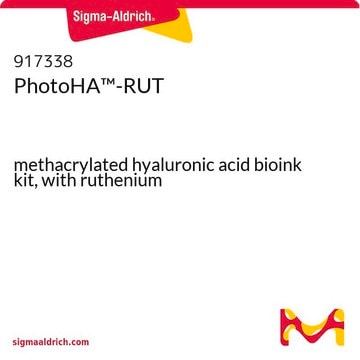The usage instructionsis as follows:
1. Calculate the desired volume of hydrogel (ECM + cells).
2. Multiply the desired volume by 0.02. This will be the amount of mL of Ruthenium and Sodium Persulfate (each) to be added to the pre-hydrogel solution.
3. Pre-solubilize the required Ruthenium in water or 1X PBS at a concentration of 37.4 mg/mL.
4. Pre-solubilize the Sodium Persulfate in water or 1X PBS at a concentration of 119 mg/mL.
5. Add the calculated volume (from step 2) of Ruthenium to the pre-hydrogel solution and mix thoroughly.
6. Add the calculated volume (from step 2) of Sodium Persulfate to the pre-hydrogel solution and mix thoroughly.
추천 제품
구성
Ruthenium (200 mg)
Sodium persulfate photoinitiator (1 g)
Quality Level
애플리케이션
신호어
Danger
유해 및 위험 성명서
Hazard Classifications
Acute Tox. 4 Oral - Ox. Sol. 3 - Resp. Sens. 1 - Skin Irrit. 2 - Skin Sens. 1 - STOT SE 3
표적 기관
Respiratory system
Storage Class Code
5.1B - Oxidizing hazardous materials
-
What are the steps to mix together and utilize product no. 916811-1EA, the Ruthenium photoinitiator kit?
1 답변-
도움이 되었습니까?
-
활성 필터
자사의 과학자팀은 생명 과학, 재료 과학, 화학 합성, 크로마토그래피, 분석 및 기타 많은 영역을 포함한 모든 과학 분야에 경험이 있습니다..
고객지원팀으로 연락바랍니다.










